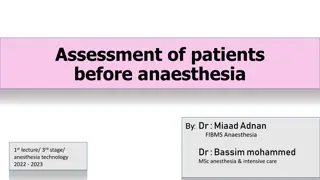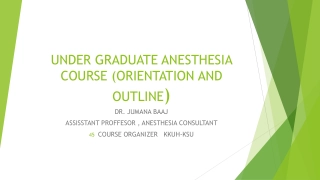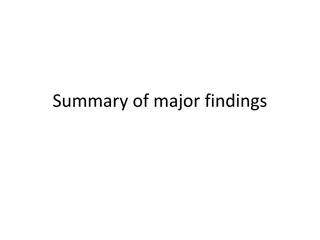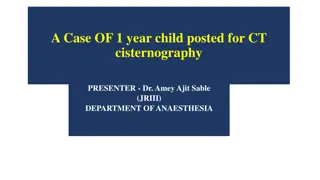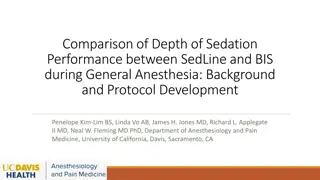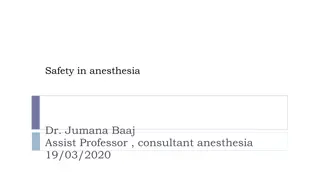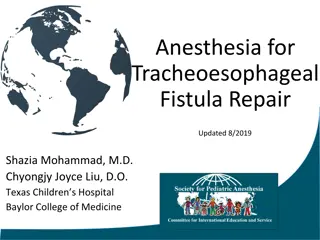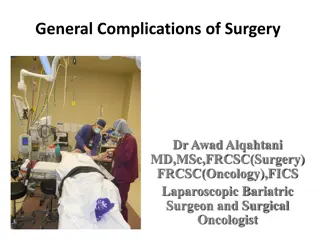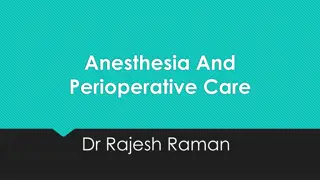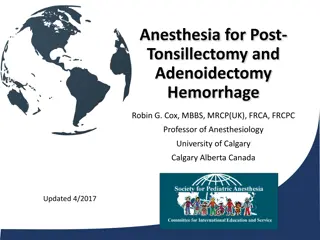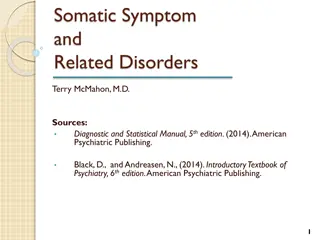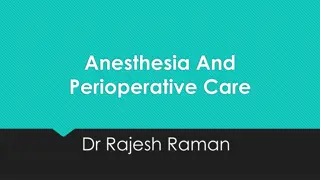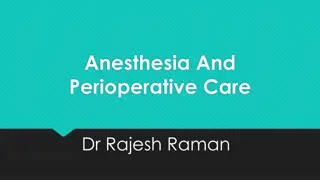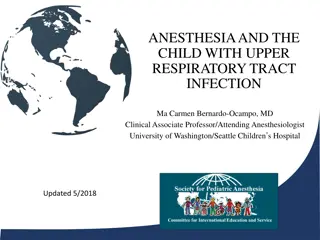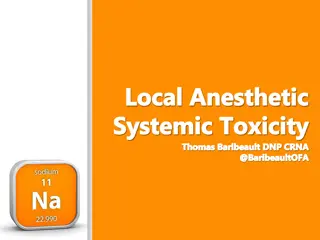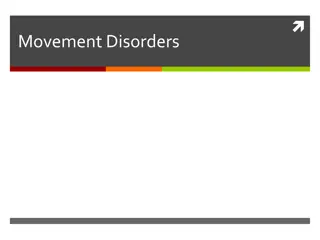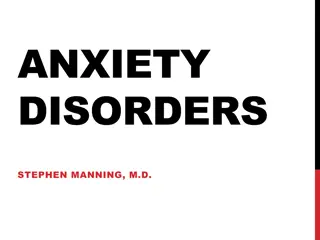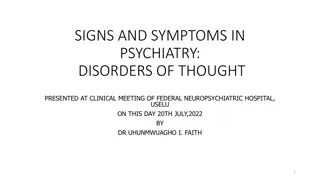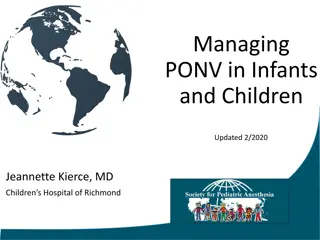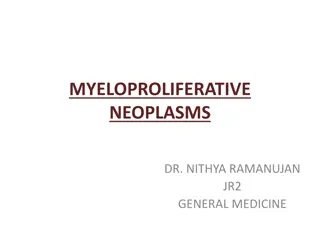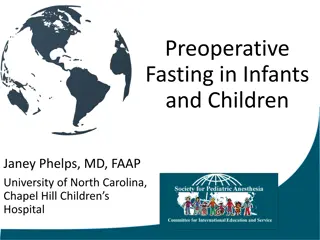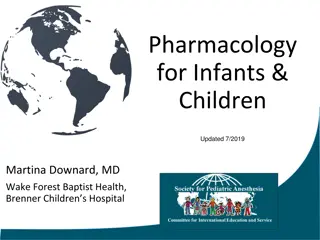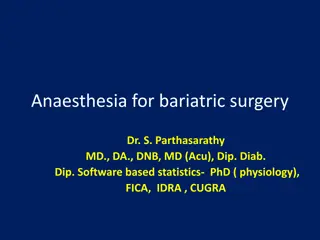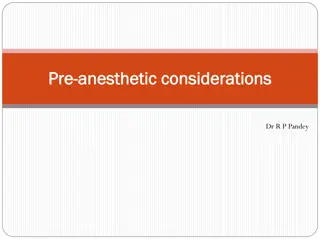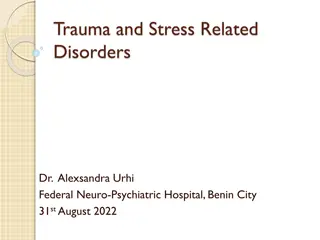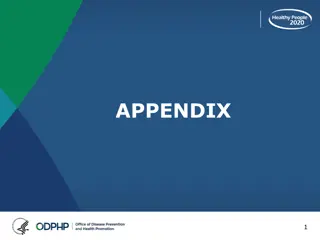Anesthesia Considerations for Neuromuscular Disorders: Overview and Management
This informative document discusses the classification of neuromuscular disorders, focusing on muscle and muscle membrane disorders such as Muscular Dystrophy. It delves into the characteristics, pathology, and clinical presentations of different types of muscular dystrophies, including Duchenne and Becker. The anesthetic management considerations for these disorders are also highlighted, providing valuable insights for healthcare professionals involved in caring for patients with neuromuscular conditions.
Download Presentation

Please find below an Image/Link to download the presentation.
The content on the website is provided AS IS for your information and personal use only. It may not be sold, licensed, or shared on other websites without obtaining consent from the author. Download presentation by click this link. If you encounter any issues during the download, it is possible that the publisher has removed the file from their server.
E N D
Presentation Transcript
Anesthesia Considerations for Neuromuscular Disorders Chris Heine, MD Medical University of South Carolina Updated 4/2019
Disclosures No relevant financial relationships
Learning Objectives Describe the different classes of neuromuscular disorders Differentiate different presentations of disorders Describe the anesthetic management of different disorders
Neuromuscular Disorders Classified by site of pathology Disorders of Muscle and Muscle Membrane Muscular Dystrophy Congenital Myopathy Myotonic Dystrophy Channelopathies Mitochondrial Disorders Neuromuscular Transmission Disorders
MUSCLE AND MUSCLE MEMBRANE DISORDERS
Muscular Dystrophy Heterogenous group of progressive muscle disorders Characterized by varying groups of muscle weakness, severity, and age of onset Pathology is result of insufficient or abnormal muscle membrane proteins (dystrophin, sargoglycan, etc) Can affect extremities, torso, face Can affect respiratory, cardiac, and GI systems
Muscular Dystrophy Duchenne and Becker Muscular Dystrophies Absent (Duchenne) or reduced (Becker) dystrophin protein Elevated Creatinine Kinase (CK) X Linked recessive inheritance Progressive proximal muscle weakness and wasting Loss of ambulation by age 12 in Duchenne Later onset of symptoms in Becker Kyphoscoliosis Cardiorespiratory symptoms lead to death by 4th decade in Duchenne, 5th-6th in Becker Typical EKG abnormalities include an R:S ratio > 1 in lead V1, deep Q waves in leads I, aVL, and V5-V6, right axis deviation, or a right bundle branch block
Muscular Dystrophies Emery-Dreifuss muscular dystrophy X-linked inheritance form the result of mutation in emerin protein, autosomal dominant form the result in mutation in lamins A and C Contractures of ankles, elbows, and neck Cardiomyopathy and conduction abnormalities by age 30
Muscular Dystrophies Limb-Girdle muscular dystrophy Varying inheritance pattern, causative gene mutation, and creatinine kinase levels Shoulder and pelvic weakness, cardiac involvement
Muscular Dystrophies Facioscapulohumeral Autosomal dominant inheritance Face, shoulder, foot, and pelvis involvement Retinal vascular disease and hearing loss Cardiac conduction abnormalities
Anesthetic Management of Children with Muscular Dystrophy Preop: Baseline CK if possible Cardiac testing usually with echocardiogram per guidelines specific to particular dystrophy Aspiration risk if GI involvement Minimize premedication if borderline respiratory status
Anesthetic Management of Children with Muscular Dystrophy Intraop: Avoid succinylcholine hyperkalemic cardiac arrest Avoid volatile anesthetic agents rhabdomyolysis Minimize, monitor and completely reverse non-depolarizing neuromuscular blockers Reserve ICU bed if post-operative ventilation is necessary No increased risk of Malignant Hyperthermia
Congenital Myopathies Central Core Disease Variable weakness Neonatal hypotonia Delayed motor milestones Multi-mini Core Disease Non-progressing Axial weakness Involves respiratory, bulbar, and extra- ocular muscles
Congenital Myopathies Nemaline Rod Disease Presents with hypotonia and feeding difficulties early in life High arched palate, micrognathia, chest deformities, finger contractures Potentially difficult intubation King-Denborough Disease Proximal muscle weakness Short stature, webbed neck, low-set ears, pectus-excavatum
Congenital Myopathies Importantly, these are all associated with Malignant Hyperthermia, particularly the variants caused by Ryanodine-1 Receptor mutations Should be considered MH susceptible unless have undergone genetic testing ruling out ryanodine receptor involvement or muscle biopsy contracture testing Perioperative concerns and management of anesthetic are similar to Muscular Dystrophy avoidance of succinylcholine and volatile anesthetics
Myotonic Dystrophy Myotonic Dystrophy Type I More common Congenital, child, adult, and late onset Distal weakness, progresses proximally Associated with premature baldness, diabetes, adrenal and thyroid deficiency Restrictive respiratory pattern Obstructive sleep apnea Cardiomyopathy and conduction delay with risk of sudden death Aspiration risk Myotonic Dystrophy Type 2 Similar features, milder clinical course Lower risk of sudden death
Anesthetic Management of Children with Myotonic Dystrophy Preoperative Type 1 more problematic Particularly cardiac and respiratory systems should be assessed Chest X-ray, ECG, echocardiogram, if available, may all assist in risk assessment Evaluate for endocrine disorders Caution with premedication
Anesthetic Management of Children with Myotonic Dystrophy Intraoperative Regional anesthesia may be beneficial Avoid succinylcholine Rapid sequence induction without neuromuscular blockade if concern for aspiration Train-of-four stimulation may appear to be tetanus, but may actually be a myotonic reaction Myotonic reaction can be treated with midazolam, but best treatment is prevention Avoid excessive stress (hypothermia), electrocautery, hyper/hypo-kalemia, and drugs that can precipitate, like succinylcholine and neostigmine Postoperative ventilation may be necessary
Channelopathies Mutations in ion channels of muscle membrane that affect muscle excitation Examples: Hyperkalemic Periodic Paralysis Hypokalemic Periodic Paralysis Andersen-Tawil Syndrome Sodium Channel Myotonia Myotonia Congenita Thyro-toxic Periodic Paralysis
Channelopathies Hypokalemic Periodic Paralysis Sodium or calcium channel mutation Flaccid paralysis, can last hours to days Triggered by high glucose meals, rest after exercise, stress, hypothermia, insulin Cardiac arrhythmias can occur
Channelopathies Hyperkalemic Periodic Paralysis Sodium ion channel mutation Prolonged muscle depolarization, flaccid paralysis, lasts minutes to hours, respiratory muscles usually spared Triggered by cold, acidosis, potassium (K+) bolus, exercise Measures to lower potassium (thiazide diuretic, CA-Inhibitor) for prevention, insulin for acute treatment
Channelopathies Andersen-Tawil Syndrome Mutation in potassium ion channel located in skeletal and cardiac myocytes Can develop paralysis associated with hypokalemia, hyperkalemia or normal potassium levels Ventricular arrhythmias and prolonged QT 10% suffer a cardiac arrest at some point Should receive yearly cardiac evaluation including ECG/Holter monitor, if feasible Potential candidates for implantable defibrillator Short stature, dysmorphic facial features, including micrognathia
Anesthetic Management of Children with Channelopathies Avoid hypothermia, acidosis, stress, or anything else that precipitates K+ swings Frequent serum K+ checks, may necessitate arterial access All may require increased level of care after surgery, if for no other reason to continue to monitor K+ closely
Anesthetic Management of Children with Channelopathies Hypokalemic Periodic Paralysis Avoid large carbohydrate load meals, B-agonists avoided prior to surgery, continue potassium sparing diuretics IV maintenance with a balanced solution, IV K+ infusion to keep in high end of patient s normal level Shorter acting neuromuscular blockers, if possible
Anesthetic Management of Children with Channelopathies Hyperkalemic Periodic Paralysis Continue potassium wasting diuretics Maintenance fluids should contain glucose and not have any K+ to maintain normoglycemia and K+ low-normal Avoid succinylcholine due to the associated K+ increase
Anesthetic Management of Children with Channelopathies Andersen-Tawil Syndrome Detailed cardiac history Avoid medications that prolong QT interval Appropriate airway precautions depending on degree of micrognathia
Mitochondrial Myopathy Heterogeneous group of mitochondrial abnormalities lead to disorder of ATP production and energy metabolism Can result in: Muscle weakness Lactic acidosis Cardiac dysfunction Hepatic and renal deficiency Multiple central and nervous system problems including seizures, paralysis, blindness, and hearing loss
Anesthetic Management of Children with Mitochondrial Myopathy Preoperative Assess degree of muscle weakness, especially respiratory muscles as many are trach/vent dependent Avoid prolonged preop fasting If necessary, preoperative admission with dextrose containing fluid for maintenance during NPO time to prevent glycolytic oxidation and lactate production
Anesthetic Management of Children with Mitochondrial Myopathy Intraoperative No lactate containing IV fluids Volatile and IV anesthetics affect mitochondria, but propofol seems to be the worst Although all anesthetics have been used safely, avoidance of prolonged use of propofol is recommended Maintain normothermia, normal glucose, normal oxygen balance to avoid lactic acid production
NEUROMUSCULAR TRANSMISSION DISORDERS
Neuromuscular Transmission Disorders: Myasthenia Gravis Autoimmune disease with antibodies directed against acetylcholine receptors Females more than males Muscle weakness that worsens with repetitive use Diplopia, dysarthria, and muscle weakness are presenting signs Myasthenia crisis can be precipitated by stress, hyperthermia, or infections Often have thymus pathology Cardiac involvement more common with thymus pathology and may include arrhythmias or Takotsubo cardiomyopathy
Neuromuscular Transmission Disorders: Myasthenia Gravis Treatment Thymectomy if thymoma present Treated with cholinesterase inhibitors, corticosteroids, immunosuppressants, intravenous immunoglobulin and plasmapheresis IVIG and plasmapheresis can assist with acute, rapid treatment Control with cholinesterase inhibitors can be problematic Under-dosing results in remaining weakness while overdosing results in a cholinergic crisis (bradycardia, excessive salivation and weakness)
Anesthetic Management of Children with Myasthenia Gravis Preoperative Patient should be assessed for possible need for postoperative ventilation Disease duration of > 6 years COPD; Taking more than 750 mg of pyridostigmine per day Vital Capacity < 2.9 L
Anesthetic Management of Children with Myasthenia Gravis Intraoperative Minimize or avoid neuromuscular blockers as small doses can result in significant weakness; if necessary use short acting neuromuscular blockers Duration of action of succinylcholine may be prolonged, especially if patient is on pyridostigmine Patients with poorly controlled myasthenia gravis can be resistant to succinylcholine Careful monitoring of neuromuscular blockade
Anesthetic Management of Children with Myasthenia Gravis Postoperative Post op ventilation may be required Extubation criteria for patients with Myasthenic Crisis* Breathing comfortably, without fatigue Normal blood gas FVC > 15 cc/kg MIP of -20 cmH2O or better
Neuromuscular Disorders and Malignant Hyperthermia Some disorders are considered to be at higher risk for Malignant Hyperthermia and patients with them are deemed MH susceptible Congenital myopathies Other myopathies if associated with specific Ryanodine or Dihydropyridine receptor gene mutations (see references in notes) Muscular Dystrophy No higher risk for MH than general population Similar precautions, but for different reasons Avoidance of succinylcholine to prevent hyperkalemia or pronounced contractures and avoidance of prolonged use of volatile anesthesia to prevent rhabdomyolysis
Neuromuscular Disorders and Malignant Hyperthermia MH susceptible patients should receive a non- triggering anesthetic following appropriate MH precautions Machine prep to clear residual volatile anesthetic Complete avoidance of succinylcholine and halogenated volatile anesthetics Dantrolene should be available on site or a plan should be in place to quickly obtain it from a nearby facility if volatile anesthesia or succinylcholine are in the hospital For further MH management, visit www.MHAUS.org or see the SPA lecture on MH
Unknown Neuromuscular Diagnosis for Surgery Risk of myopathic, hypotonic patient with unknown disorder developing MH is very low If possible, regional anesthesia preferred Succinylcholine must be avoided, regardless of potential diagnosis Volatile anesthesia only briefly for induction if muscular dystrophy is higher on differential diagnosis Propofol only briefly for induction if mitochondrial myopathy is higher on differential diagnosis
Conclusions Neuromuscular disorders cover a wide variety of pathologies Identifying the specific disorder or the source of the pathology can help guide your anesthetic management Be aware of the treatment medications patients are taking as they may affect your anesthetic Caring for the hypotonic child with an unknown diagnosis can be complicated, but the risk of an MH reaction is low
Additional References 1. Dierdorf S, Walton J, Stasic A, Heine, C. Rare Coexisting Diseases. In Barash P, Cullen B, Stoelting R eds. Clinical Anesthesia. 8th ed. Philadelphia, PA: Wolters Kluwer, 2017:612-643 2. Emery A. The muscular dystrophies. The Lancet 2002;359:687-695 3. Flick R, Gleich S, Herr M, Wedel D. The risk of malignant hyperthermia in children undergoing muscle biopsy for suspected neuromuscular disorder. Paediatr Anaesth 2007;17:22-7 4. Katz J, Murphy G. Anesthetic consideration for neuromuscular diseases. Current Opinion in Anesthesiology 2017;30(3):435-440 5. Mercuri E, Muntoni F. Muscular dystrophies. The Lancet 2013;381:845-860 6. Racca F, Mongini T, Wolfler A, Vianello A, Curera R, et al. Recommendations for anesthesia and perioperative management of patients with neuromuscular disorders. Minerva Anestesiologica 2013;79(4)419-33 7. Romero A, Joshi G. Neuromuscular disease and anesthesia. Muscle & Nerve 2013;48:451-460 8. Schwartz J. Skin and Musculoskeletal Diseases. In Hines R, Marschall K, eds. Stoelting s anesthesia and co-existing disease. 5th ed. Philadelphia, PA: Elsevier, Inc; 2008:437-467 9. Veyckemans F. Can inhalation agents be used in the presence of a child with myopathy? Current Opinion in Anesthesiology 2010;23:348-355 10. Yilmaz A, Sechtem, U. Cardiac involvement in muscular dystrophy: advances in diagnosis and therapy. Heart 2012;98:420-429



